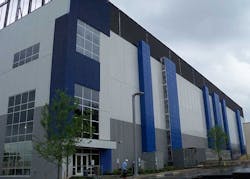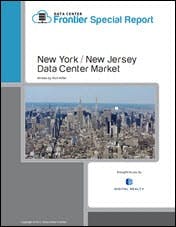We continue our series of stories on the leading geographic markets for data center space. Data Center Frontier partnered with DatacenterHawk to provide in-depth market reports on each city we profile. Read on for a special excerpt from the report that explores the New York and New Jersey Data Center Market.
Download the full Report.
It’s no surprise the New Jersey data center market has grown over the past few years. Even with the threat of oversupply two years ago, the market has continued to see demand and activity from data center users and operators.
The New Jersey data center market is home to 2.14 million SF of data center, representing 234 MW of commissioned power, according to research from DatacenterHawk. With a vacancy rate of 18.1 percent, New Jersey has more unfilled space than most major data center markets, reflecting lower demand. The state saw absorption of 13.2 MW of space in 2016 as activity began to pick up.
The Northern New Jersey colocation market has grown considerably over the last few years for the following reasons:
- Proximity to New York City — Firms with a need to be close to the city have found more reliable and cost-effective options in Northern New Jersey.
- Robust Infrastructure — The Northern New Jersey market’s infrastructure serves the needs of data center users and providers consistently.
- Favorable Business Climate — Companies find New Jersey more business-friendly compared to the challenging business environment found in New York City, and the concentration of those companies generate data center requirements for the region.
Northern New Jersey’s data center market experienced a building frenzy that started in 2005, but fizzled after an economic recession led to an excess of supply. In 2008, the New Jersey market featured many companies that built, owned, and operated their own enterprise data centers.
[clickToTweet tweet=”Data Center Frontier – The New Jersey data center market is home to 2.14 million SF of data center. ” quote=”Data Center Frontier – The New Jersey data center market is home to 2.14 million SF of data center.”]
The financial implosion of 2009 helped fuel the rise of the colocation market as data center providers scoured Northern New Jersey for sites and opportunities to offer solutions to these companies. The industry regulations around data security and internal capital regulation instituted after the crash also made colocation more attractive.
In addition, for both economic and security reasons, the New York Stock Exchange and NASDAQ have moved their data centers out of New York City and into Northern New Jersey. Larger providers like Digital Realty, DuPont Fabros, and Sentinel Data Centers were well positioned to capitalize on the market conditions at the time and enjoyed steady growth.
The majority of data center activity in the New Jersey market can be seen in two areas: The I-95 Corridor in Northern New Jersey and in Central New Jersey along Route I-287 (approximately 30 miles to the southwest).
The Northern NJ market on the I-95 Corridor includes the following cities: Weehawken, Jersey City, Carlstadt, Secaucus, Clifton, and Newark. Several major U.S. data center providers occupy the Northern New Jersey I-95 Corridor.
- Jersey City contains data center providers near the Hudson River, typically with data centers taking up a floor or several floors in high-rise buildings. Smaller users with managed IT needs find these offerings from CenturyLink and QTS most attractive.
- Weehawken is three miles to the north, where CenturyLink, Digital Realty, and Telx have invested significantly in facilities and services over the past four years. Its location immediately across the river from Wall Street has made Weehawken an important site for financial applications and high-frequency trading.
- Secaucus, a city two and half miles west, has been a recipient of major data center activity recently. It is a key hub for Equinix, which has multiple data centers with a strong financial ecosystem. AT&T, CoreSite, Internap, and vXchnge are all located in Secaucus.
- Other providers within close proximity to the I-95 Corridor are Digital Realty (Telx), with facilities in Clifton, and Sungard, which operates three facilities in Carlstadt, NJ. Equinix (NY1) is also located in Newark, NJ.
Activity in the I-287 area is also brisk. The Central NJ market includes Edison, Piscataway, and Somerset.
The most significant investment in this area comes in Piscataway, where AT&T, CenturyLink, Digital Realty, QTS Data Centers, Green House Data, and Verizon all have data centers. IO Data Centers landed their 830,000 SF building in Edison, NJ in 2011. They are focused on delivering their modular product at the facility. Somerset is directly to the west from Piscataway, where Digital Realty, One Neck IT Solutions, and CyrusOne have facilities.
Several deals have altered the competitive landscape in Central New Jersey, with QTS acquiring the DuPont Fabros NJ1 facility in Piscataway, while CyrusOne bought the Sentinel data center in Somerset.
The market is occasionally tested with strong winds and rains from hurricanes that form along the East Coast. Despite careful preparations, Hurricane Sandy in 2012 proved more damaging than most data center operators and users expected. While the challenges created in Northern New Jersey were less than the issues in New York City, it was still a major event for the area. Many data centers lost power, but were switched to generator power and continued to serve their customers without interruption.
The data center providers impacted by Hurricane Sandy all had contracts with local fuel suppliers, who stood by when generators required refueling.
The Carlstadt area, where Sungard has a strong presence, dealt with nearby levees breaking and flooding, with one of the company’s data centers serving as a refuge for flooded residents and temporary command center for local officials.
The impact from Hurricane Sandy forced many users to evaluate their data center strategy and ways to mitigate future risk from similar events.
Our series on the New York/New Jersey data center market also covers the following topics:
- Leasing Absorbing Space in New York Data Center Market
- New York Data Center Market Report: Supply & Demand Trends
- New Jersey Data Center Market Report: An ‘Upswing in Interest’
For more on the New York/New Jersey data center market, we invite you to download the “Data Center Frontier Special Report: The New York/New Jersey Data Center Market,” sponsored by Digital Realty.
About the Author





